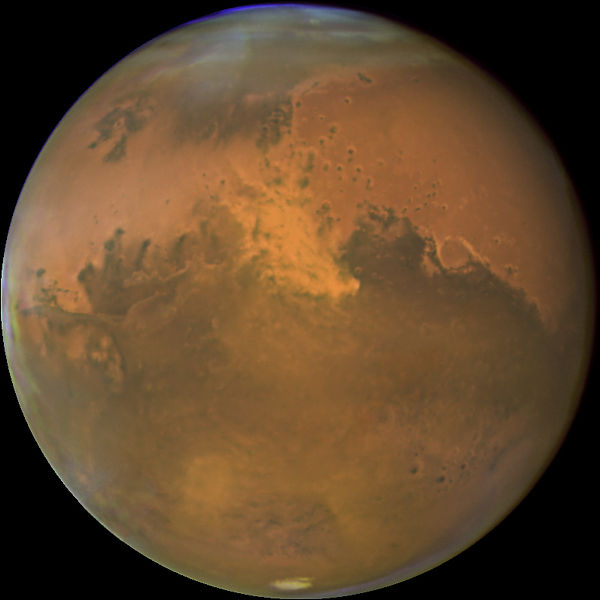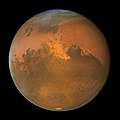Ofbeeldienge:2005-1103mars-full.jpg

Grootte van deze voorvertoning: 600 × 600 pixels. Andere resoluties: 240 × 240 pixels | 480 × 480 pixels.
Ofbeeldienge in een ôgere resolutie (800 × 800 pixels, bestandsgrootte: 232 kB, MIME-type: image/jpeg)
Bestandsgeschiedenisse
Klik op een datum/tijd om het bestand te zien zoals het destijds was.
| Datum/tijd | Miniatuur | Afmetingen | Gebruiker | Opmerking | |
|---|---|---|---|---|---|
| huidige versie | 19 jun 2009 16:52 |  | 800 × 800 (232 kB) | Tryphon | Higher resolution. |
| 1 jan 2006 01:21 |  | 700 × 700 (34 kB) | Pringles | NASA's Hubble Space Telescope snapped this picture of Mars on October 28, within a day of its closest approach to Earth on the night of October 29. Hubble astronomers were also excited to have captured a regional dust storm on Mars that has been growing |
Bloadn met dizze ofbeeldienge
Der is/zyn verwyzieng(e)n noar dit bestand ip de volgende bloadn:
Globaal bestandsgebruik
De volgende andere wiki's gebruiken dit bestand:
- Gebruikt op af.wikipedia.org
- Gebruikt op beta.wikiversity.org
- Gebruikt op bg.wikipedia.org
- Gebruikt op ca.wikipedia.org
- Gebruikt op el.wikipedia.org
- Gebruikt op en.wikipedia.org
- Gebruikt op en.wikiquote.org
- Gebruikt op en.wikiversity.org
- User:Marshallsumter/Radiation astronomy1/Planets/Sciences
- User:Marshallsumter/Radiation astronomy2/Reds
- User:Marshallsumter/Radiation astronomy/Chemistry
- User:Marshallsumter/Radiation astronomy1/History
- Solar System, technical/Classical planets
- User:Marshallsumter/Keynote lectures (draft)/Meteor radiation astronomy
- User:Marshallsumter/Radiation astronomy1/Planets/Classicals
- Draft:Original research/Planets
- User:Marshallsumter/Radiation astronomy2/Visuals/Quiz
- User:Marshallsumter/Rocks/Rocky objects/Astronomy
- User:Marshallsumter/Radiation astronomy/Courses/Principles/Hourly 2
- User:Marshallsumter/Radiation astronomy/Courses/Principles/Midterm quiz
- User:Marshallsumter/Radiation astronomy/Courses/Principles/Final quiz
- Titan/Quiz
- User:Marshallsumter/Rocks/Rocky objects
- Draft:Enceladus/Quiz
- Moon/Quiz
- Stars/Sun/Heliology/Quiz
- Earth/Quiz
- User:Marshallsumter/Radiation astronomy/Clouds
- User:Marshallsumter/Radiation astronomy/Cryometeors
- User:Marshallsumter/Radiation astronomy1/Lithometeors
- Stars/Reds/Quiz
- Draft:Dione/Quiz
- User:Marshallsumter/Radiation astronomy2/Scattered disks/Quiz
- User:Marshallsumter/Radiation astronomy1/Kuiper belts/Quiz
- WikiJournal Preprints/Cryometeors
- Gebruikt op es.wikipedia.org
- Gebruikt op fa.wikipedia.org
- Gebruikt op fr.wikipedia.org
- Gebruikt op fr.wikinews.org
- Gebruikt op gn.wikipedia.org
- Gebruikt op hi.wikipedia.org
- Gebruikt op hu.wikipedia.org
Globaal gebruik van dit bestand bekijken.

